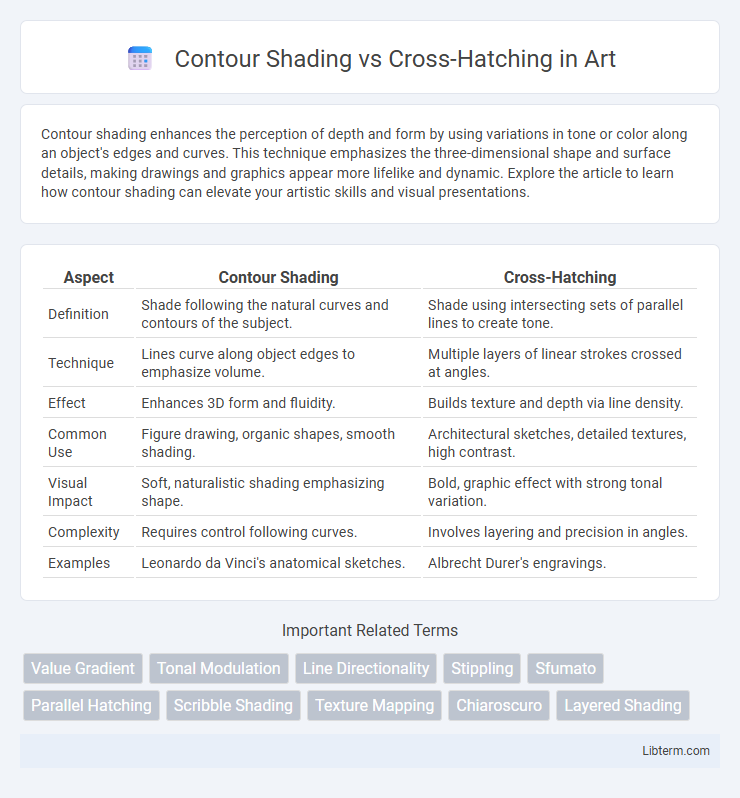Contour shading enhances the perception of depth and form by using variations in tone or color along an object's edges and curves. This technique emphasizes the three-dimensional shape and surface details, making drawings and graphics appear more lifelike and dynamic. Explore the article to learn how contour shading can elevate your artistic skills and visual presentations.
Table of Comparison
| Aspect | Contour Shading | Cross-Hatching |
|---|---|---|
| Definition | Shade following the natural curves and contours of the subject. | Shade using intersecting sets of parallel lines to create tone. |
| Technique | Lines curve along object edges to emphasize volume. | Multiple layers of linear strokes crossed at angles. |
| Effect | Enhances 3D form and fluidity. | Builds texture and depth via line density. |
| Common Use | Figure drawing, organic shapes, smooth shading. | Architectural sketches, detailed textures, high contrast. |
| Visual Impact | Soft, naturalistic shading emphasizing shape. | Bold, graphic effect with strong tonal variation. |
| Complexity | Requires control following curves. | Involves layering and precision in angles. |
| Examples | Leonardo da Vinci's anatomical sketches. | Albrecht Durer's engravings. |
Introduction to Contour Shading and Cross-Hatching
Contour shading emphasizes following the natural curves and shapes of a subject through smooth, flowing lines to create depth and volume, closely mimicking three-dimensional form. Cross-hatching employs layers of intersecting parallel lines, varying in density and direction, to build tonal values and texture by manipulating light and shadow. Both techniques are fundamental in drawing, with contour shading highlighting shape and form, while cross-hatching enhances tonal contrast and surface detail.
Understanding Contour Shading Techniques
Contour shading emphasizes the use of lines that follow the natural curves and shapes of an object, creating depth and volume by mimicking its three-dimensional form. This technique relies on varying line thickness and spacing to convey light and shadow, enhancing the illusion of texture and structure. Mastery of contour shading requires careful observation of the object's surfaces to produce smooth transitions and realistic shading effects.
Exploring the Fundamentals of Cross-Hatching
Cross-hatching utilizes multiple layers of intersecting lines to create depth, texture, and tonal variation, enhancing the dimensionality of a drawing more effectively than contour shading, which follows the form's outline. The technique originated from classical etching and engraving practices, emphasizing precision and layering density to simulate shadows and light. Mastering cross-hatching requires understanding line direction, spacing, and pressure to build gradients, making it a versatile tool for realistic and expressive artwork.
Tools and Materials for Each Shading Method
Contour shading primarily utilizes smooth pencils, blending stumps, and tortillons to create gradual transitions along the form's curves, emphasizing volume and depth. Cross-hatching requires fine-tipped pens, technical liners, or hard pencils, enabling precise, intersecting lines that build texture and tonal variations. Paper choice varies with contour shading favoring smoother surfaces for seamless blending, while cross-hatching benefits from slightly textured papers to enhance line grip and definition.
Visual Differences: Contour Shading vs Cross-Hatching
Contour shading emphasizes smooth gradations that follow the form's curves, creating a three-dimensional illusion through continuous, flowing lines. Cross-hatching relies on intersecting sets of straight or slightly curved lines at varying angles, producing texture and tonal variation with a linear, grid-like structure. Visually, contour shading appears softer and more organic, while cross-hatching presents a more structured, geometric pattern that builds depth through layered line density.
Artistic Effects and Textures Achieved
Contour shading creates smooth, flowing gradients that emphasize the form and volume of subjects, producing a naturalistic texture ideal for soft surfaces like skin or fabric. Cross-hatching uses intersecting lines at varying densities and angles to build depth, contrast, and a rougher, more tactile texture suitable for complex patterns or dramatic shadows. Both techniques offer unique artistic effects; contour shading excels in subtle tonal transitions, while cross-hatching delivers boldness and structural definition.
Choosing the Right Technique for Your Artwork
Choosing the right technique between contour shading and cross-hatching depends on the desired texture and depth in your artwork. Contour shading emphasizes smooth, curved lines that follow the shape of the subject, enhancing three-dimensional form and volume, while cross-hatching uses intersecting lines to create varying tonal values and intricate shading effects. Artists should select contour shading for softer transitions and organic forms or cross-hatching when aiming for detailed texture and dynamic contrast.
Common Mistakes and How to Avoid Them
Common mistakes in contour shading include inconsistent pressure and ignoring light sources, resulting in flat or unnatural textures. Cross-hatching errors often involve uneven line spacing or direction, which can disrupt the intended depth and form. To avoid these issues, maintain controlled pencil pressure in contour shading and practice uniform, deliberate line patterns in cross-hatching while constantly referring to the light source for accurate shading.
Tips for Improving Your Shading Skills
Master contour shading by following the natural curves of the subject to create depth and dimension, enhancing realism in your artwork. Cross-hatching requires varied line density and direction to build texture and tonal value effectively, so practice layering strokes with consistent pressure. Use reference images and experiment with different pencil grades to refine control and achieve smoother gradients in both techniques.
Conclusion: Which Technique Fits Your Style?
Contour shading emphasizes smooth transitions and volume by following the shape's natural curves, ideal for artists seeking realistic depth and subtlety. Cross-hatching builds texture and tonal variation through intersecting lines, perfect for those who prefer bold contrasts and dynamic patterns. Choosing between contour shading and cross-hatching depends on your stylistic goals: opt for contour shading to capture softness and form, or select cross-hatching to achieve dramatic texture and intensity.
Contour Shading Infographic

 libterm.com
libterm.com